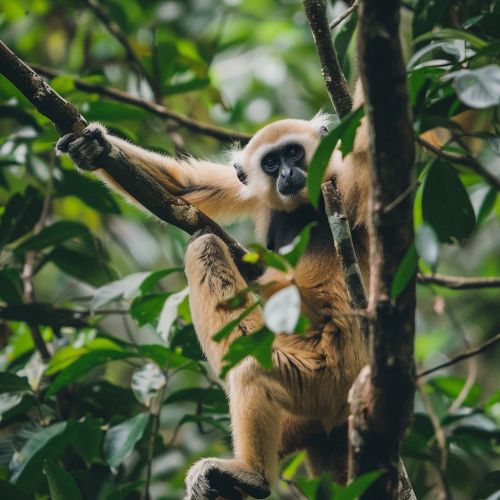Hylobatidae
Taxonomy and Evolution
The family Hylobatidae, also known as gibbons, is a member of the primate order Primates. This family is part of the superfamily Hominoidea, which also includes the great apes and humans. The Hylobatidae family is divided into four genera: Hylobates, Hoolock, Nomascus, and Symphalangus. These genera encompass a total of 18 species, all of which are native to the forests of Southeast Asia.


The evolution of gibbons is a topic of ongoing research. The fossil record for gibbons is sparse, but molecular data suggest that the family diverged from the great apes around 16.8 million years ago during the Miocene epoch. The four genera of gibbons are believed to have diverged from a common ancestor approximately 5 million years ago.
Physical Characteristics
Gibbons are small, arboreal apes characterized by their long arms, which they use for brachiation, a form of locomotion that involves swinging from branch to branch. Their bodies are adapted for this mode of movement, with a flexible, rotating wrist joint and a shortened thumb. Gibbons also have a reduced index finger, allowing for a stronger grip on branches.
Their fur color varies from black and dark-brown to light-brown, sandy colors. Some species have distinctive facial features such as bright white eyebrows or cheeks. Unlike the great apes, gibbons do not exhibit sexual dimorphism, meaning males and females are roughly the same size.
Behavior and Ecology
Gibbons are diurnal, meaning they are active during the day. They are also highly territorial and live in small, monogamous groups consisting of a mated pair and their offspring. The family group defends its territory by singing complex, melodious songs, which also serve to strengthen pair bonds and communicate with other gibbon families.
Their diet primarily consists of fruits, leaves, and small animals. They play a crucial role in their ecosystem as seed dispersers, contributing to the health and diversity of the forest.
Conservation Status
Many species of gibbons are critically endangered, primarily due to habitat loss from deforestation and hunting. Conservation efforts are ongoing and include habitat protection, anti-poaching measures, and captive breeding programs. However, the recovery of gibbon populations is a slow process due to their slow reproductive rates.
